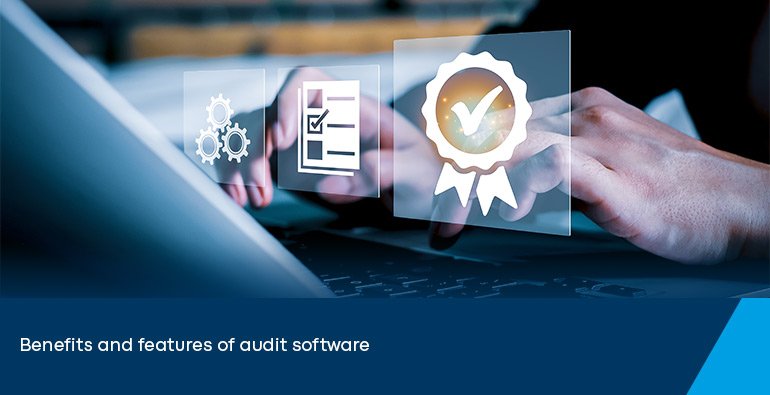Audit software: How to optimally prepare, document and successfully conduct audits

Audit software simplifies the time-consuming, lengthy and complex audit and compliance process. It helps you to comply with laws, standards, and other regulations. Pressure to act arises at the latest when companies grow, open up new markets or when the legal situation changes. In most cases, spreadsheet software is no longer sufficient. But for whom is a special audit tool suitable? And what requirements does it cover? An overview of everything important about audit software.
Content of this article
- How does audit software work?
- What are the benefits of audit management software?
- Which companies do need an audit software?
- How can I tell if an audit tool is the right one?
- What requirements must multi-standard solutions meet?
- Audit software checklist: What to consider when choosing
How does audit software work?
Audit software supports companies in their entire audit process, i.e. audits, self-assessments, individual audits, and audit programs. It helps to document and manage internal as well as external requirements and to reliably monitor their compliance. Audit logs or reports for internal auditing can also be created automatically with audit management software. This optimizes the entire audit process and simplifies compliance.
The most important functions of an audit software are:
- Structured requirement catalogs that can be completed step by step
- Derivation of definitions and concrete tasks
- Development and implementation of control mechanisms
- Automated reports (for example, audit reports and audit planning)
- Coordination of audit meetings with assignments of roles and responsibilities
- Audit-proof and seamless documentation of all changes and relevant processing steps
What are the benefits of audit management software?
Audit software allows companies to map, execute and document their entire audit and compliance process. This brings with it several advantages:
- Simple and secure monitoring of audits and compliance requirements
- Overview of all relevant internal and external requirements, the current status and any deviations
- Timely initiation of preventive (via integrated risk management) and corrective measures
- Demonstrable adherence to all necessary laws, standards and compliance requirements
- Easy passing of audits, controls and supplier qualifications
- Avoidance of legal sanctions or damage to image
- Optimization of quality-related processes and secure implementation of security and data protection requirements
- Simplified cooperation with federal and state authorities
Which companies do need an audit software?
Audit management software is suitable for any organization that regularly has to meet external and internal requirements—regardless of which laws, standards or guidelines these are. Thus, large, small and medium-sized companies as well as NGOs and public institutions can benefit from an audit tool. This is especially true for those industries that are particularly heavily regulated—such as the financial and insurance sectors or utilities-related institutions.
It is important that the audit software used supports the specific regulations of the industry in question. For automotive groups, for example, the IATF 16949, VDA 6.3 and VDA TISAX standards should be integrated into the application. For hospitals, retirement homes and other healthcare facilities, on the other hand, DIN EN 15224, ISO 13485 and B3S Health are important. The German Federal Office for Information Security (BSI) provides security-relevant information for individual industries.
How can I tell if an audit tool is the right one?
Which laws, standards or guidelines are included in an audit software depends on the respective manufacturer. Therefore, companies should create a requirements profile in advance and then match it with the features of the software.
OMNITRACKER Audit and Compliance Management, for example, can be individually adapted to a company's own organization. The multi-standard solution is part of the OMNITRACKER GRC Center, which allows companies to manage all their risk and compliance aspects in a centralized way on one platform. The integration of all three levels of action—i.e. governance, risk management, compliance—of good corporate governance, which overlap and interact in terms of content, additionally simplifies monitoring.
What requirements must multi-standard solutions meet?
OMNINET’s audit software supports companies in managing their audits and compliance requirements. It maps five audit types that can be customized:
- Process audits
- Project audits
- Certification audits
- Management system audit
- Individual audits
Thanks to its multi-standard functionality, the audit software is suitable for all industries and organizational dimensions. Industry-independent requirement catalogs such as information security management system (ISMS) according to ISO 27001 and quality management system (QMS) according to ISO 9001 are also integrated, as well as features according to ISO 19600 and 19011 and B3S-KRITIS audits according to the BSI’s IT-Grundschutz.
All necessary requirement catalogs can be freely defined in the audit tool and easily imported including the relevant questionnaires. This means that various laws, standards, guidelines and processes can be dealt with and prepared. This flexibility helps to establish new audit processes in time.
In addition, there is integrated risk management, a role-specific cockpit with personalized task list, an automated knowledge database and a real-time information system with Business Intelligence.
Audit software checklist: What to consider when choosing
- A modular structure of the audit software allows the scope of functions to be expanded as needed.
- Multi-standard capability allows all necessary laws, norms and standards to be digitally mapped.
- Standardized interfaces ensure that the audit tool can flexibly access data from the existing software landscape.
- An experienced and established manufacturer guarantees long-term stability.
- The manufacturer of the audit software should have consulting services available if required.